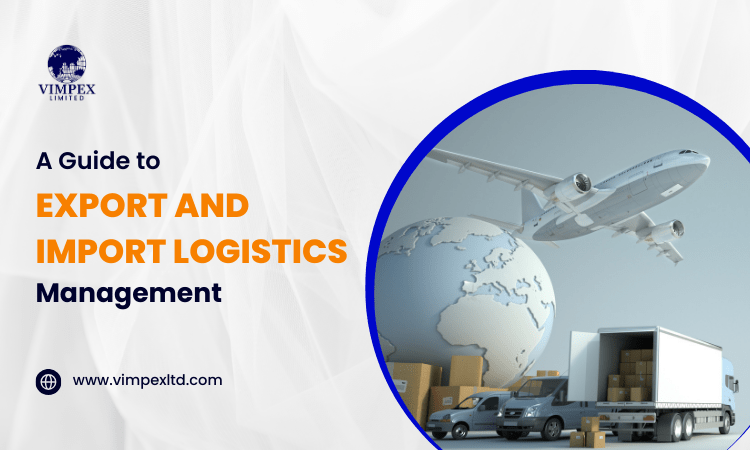Introduction:
In today’s interconnected world, businesses are increasingly looking to expand their reach beyond domestic markets. Exporting and importing goods can be a powerful way to grow your business, but navigating the complexities of international trade can be daunting. This comprehensive guide is designed to equip you with the knowledge and tools you need to master export and import logistics management. We’ll delve into the key steps involved in the process, from identifying potential markets to navigating customs regulations and ensuring efficient delivery. Whether you’re a seasoned international trader or just starting out, this guide will provide valuable insights and practical strategies to help you unlock the full potential of global markets.
1. Demystifying Export & Import: Key Steps & Considerations for Entering New Markets:
The prospect of entering new markets through exporting and importing can be both exciting and intimidating. While the potential for growth is significant, navigating the complexities of international trade can feel overwhelming. This section aims to demystify the process by outlining key steps and considerations to help you navigate your journey confidently.
Market Research & Selection:
Thorough research is crucial. Identify countries with demand for your product or service, considering factors like market size, regulations, and economic stability. Analyze competitor presence and potential cultural differences.
Product & Pricing Strategy:
Adapt your product or service to local regulations and consumer preferences. Research pricing strategies considering factors like import duties, transportation costs, and competitor pricing.
Identify Partner & Logistics:
Establishing partnerships with freight forwarders, customs brokers, and local distributors can streamline logistics, compliance, and market access.
Understand Regulations & Documentation:
Familiarize yourself with import and export regulations of both your home country and the target market. This includes understanding customs procedures, required documentation (e.g., invoices, certificates of origin), and potential licensing requirements.
Optimize Your Supply Chain:
Develop a cost-effective and efficient supply chain for delivering your goods. Consider factors like transportation options, customs clearance times, and inventory management strategies.
Communication & Cultural Sensitivity:
Effective communication and cultural sensitivity are paramount. Build strong relationships with your partners and clients by understanding and respecting local customs and business practices.
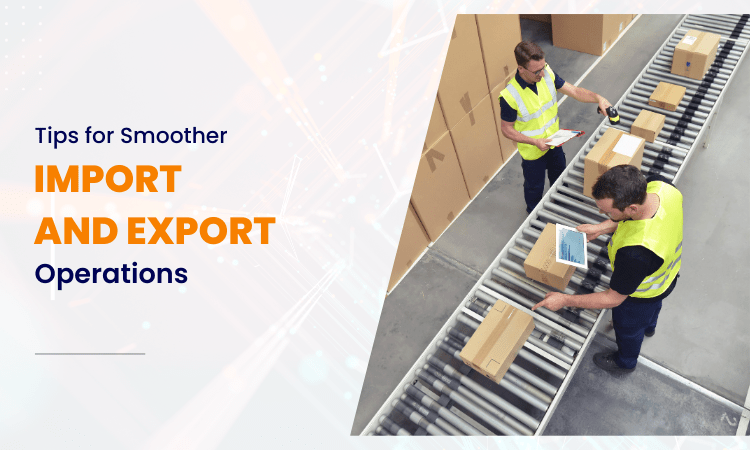
2. Optimizing Your Global Supply Chain: Tips for Smoother Import & Export Operations:
In an increasingly interconnected world, a well-oiled global supply chain is crucial for seamless import and export operations. However, navigating the complexities of international trade can lead to delays, disruptions, and increased costs. Here are some key tips to optimize your global supply chain for smoother import and export experiences:
Establish Strong Partnerships:
Build strategic partnerships with reliable logistics providers, including freight forwarders, customs brokers, and potentially, local distributors in your target market. These partners can offer valuable expertise in navigating regulations, streamlining logistics, and ensuring efficient customs clearance.
Leverage Technology:
Utilize technology solutions to streamline your supply chain processes. Consider implementing warehouse management systems and transportation management systems to gain real-time visibility into your inventory levels, shipment locations, and potential delays.
Prioritize Transparency & Communication:
Maintain transparent communication with all stakeholders throughout the supply chain, including suppliers, freight forwarders, and customers. Timely updates on order status, potential delays, and any changes in regulations can prevent disruptions and build trust.
Proactive Risk Management:
Identify potential risks associated with your global supply chain, such as weather disruptions, political instability, or changes in trade regulations. Develop contingency plans to mitigate these risks and minimize their impact on your operations.
Continuously Analyze & Improve:
Regularly monitor the performance of your import and export operations. Identify areas for improvement, such as reducing lead times, optimizing packaging, or negotiating better transportation rates. Continuously refine your processes to ensure efficiency and cost-effectiveness across your global supply chain.
3. The Power of Partnerships: Leveraging Logistics Expertise in Export & Import:
Venturing into the world of international trade, whether through exporting or importing, can be an exciting opportunity for business growth. However, navigating the complexities of logistics, regulations, and cultural nuances in unfamiliar markets can be daunting. This is where the power of partnerships truly shines.
Leveraging expertise:
Partnering with experienced logistics providers like freight forwarders and customs brokers can significantly ease the burden of managing your import and export operations. These specialists possess in-depth knowledge of transportation routes, customs regulations, and clearance procedures, saving you time, money, and frustration.
Streamlining the process:
Your partners can handle crucial aspects of your logistics journey, from selecting the most cost-effective and reliable transportation options to navigating complex customs documentation and procedures. This allows you to focus on core business activities while ensuring your goods reach their destination efficiently.
Building local connections:
When entering new markets, establishing partnerships with local distributors or logistics providers can provide invaluable insights and connections. These local partners can offer cultural expertise, navigate specific regional regulations, and help you build stronger relationships with local customers and suppliers.
Mitigating risks:
The global landscape can be unpredictable, and unforeseen circumstances can disrupt your operations. Partnering with experienced players in the field allows you to benefit from their expertise in risk mitigation. They can help you anticipate potential challenges, develop contingency plans, and ensure your supply chain remains resilient.
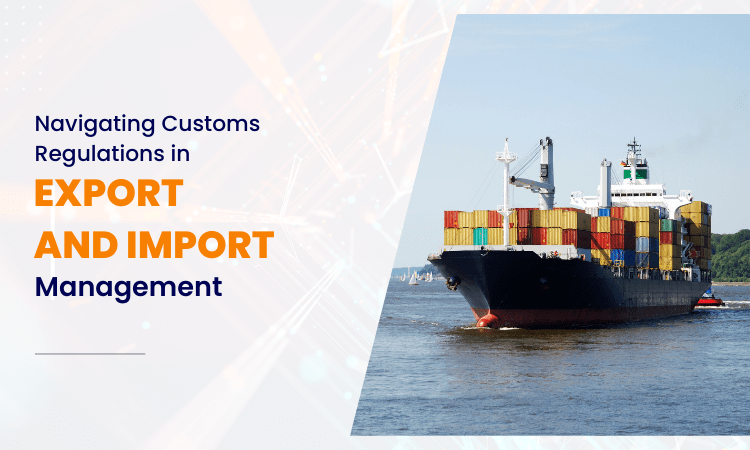
4. Compliance Counts: Navigating Customs Regulations in Export & Import Management:
Compliance with customs regulations is paramount in export and import management. Failure to adhere to these regulations can result in delays, penalties, or even the seizure of your goods, causing significant disruptions and financial losses.
Understanding the key aspects of customs regulations is crucial for smooth and efficient international trade:
Classification:
Accurately classifying your goods under the Harmonized System (HS) code is vital. This code determines the applicable import duties and taxes. Consulting the HS code list or seeking guidance from a customs broker is crucial to ensure proper classification.
Required Documentation:
Ensure you have all the necessary documentation for each shipment, including commercial invoices, packing lists, certificates of origin, and any permits or licenses required for specific goods. Missing or inaccurate documentation can lead to delays and additional scrutiny.
Duty & Tax Payments:
Understand and pay the required import duties and taxes associated with your goods. These vary depending on the product category, country of origin, and trade agreements in place. Failing to pay these charges can result in penalties or even confiscation of your goods.
Stay Updated:
Customs regulations can change frequently, so staying informed about updates and revisions is vital. Utilize resources provided by your local customs authorities or subscribe to relevant updates from trade organizations.
Seek Expert Advice:
Navigating the intricacies of customs regulations can be complex. Consider seeking professional guidance from customs brokers or trade consultants. They can help ensure compliance, minimize risks, and streamline your import and export processes.
By prioritizing compliance and actively managing customs regulations, you can avoid unnecessary delays, penalties, and disruptions. This ensures a smoother and more efficient experience in your international trade endeavors. Remember, remaining compliant is not just essential for avoiding legal issues; it also builds trust and fosters a positive relationship with customs authorities, ultimately facilitating smoother international business activities.
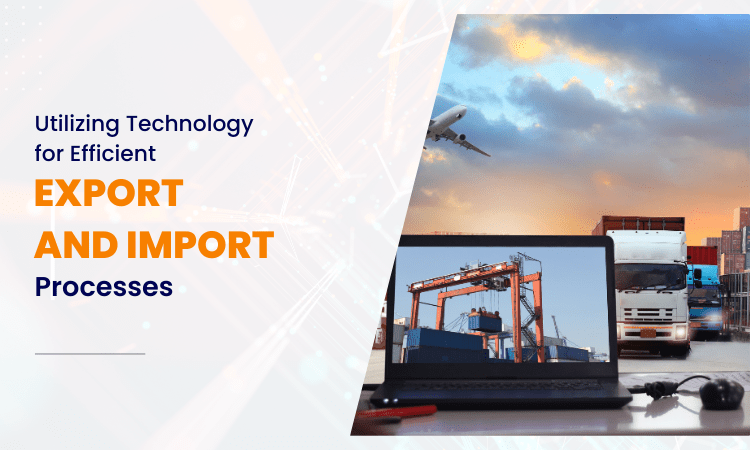
5. Tech-Enabled Trade: Utilizing Technology for Efficient Export & Import Processes:
The world of international trade is undergoing a technological revolution. Businesses are increasingly leveraging innovative solutions to streamline their export and import processes, enhancing efficiency, transparency, and cost-effectiveness.
Cloud-Based Solutions:
Cloud-based logistics management systems (LMS) offer centralized access to real-time shipment data, inventory levels, and customs documentation. This allows for improved collaboration between teams, faster decision-making, and better visibility into the entire supply chain.
Automation & Streamlining:
Automation tools can automate repetitive tasks such as data entry, document generation, and customs clearance procedures. This reduces human error, saves time, and increases the efficiency of your export and import operations.
Track & Trace Technology:
Real-time tracking systems utilizing GPS and RFID technologies allow you to monitor your shipments in real-time, providing valuable insights into their location, movement, and potential delays. This enhances transparency and enables proactive communication with clients.
E-commerce Platforms:
Online marketplaces and e-commerce platforms offer businesses greater access to international buyers and sellers. These platforms simplify the process of finding potential partners, negotiating deals, and managing online transactions.
Big Data & Analytics:
Utilizing data analytics tools allows you to gain valuable insights from your import and export activities. By analyzing past data, you can identify trends, optimize your pricing, and make informed decisions regarding sourcing, logistics, and market expansion strategies.
6. Cost-Effective Strategies: Minimizing Expenses in Import & Export Logistics:
The success of your import and export ventures hinges on managing costs effectively. While international trade offers exciting growth opportunities, navigating logistics can be expensive. By implementing these cost-effective strategies, you can minimize your expenses and maximize your profits:
Optimize Transportation:
Carefully choose your transportation mode based on urgency and cost considerations. While air freight is faster, sea freight offers significant cost savings, especially for bulkier shipments. Consider consolidation options where multiple smaller shipments are combined into one larger one for better rates.
Packaging Optimization:
Utilize right-sized, lightweight packaging materials to minimize dimensional weight charges and optimize space utilization in containers. Explore alternative packaging options like inflatable dunnage to secure goods efficiently without adding unnecessary weight.
Negotiate & Compare Rates:
Don’t settle for the first quote you receive. Research and compare rates from different logistics providers to find the best value for your specific needs. Negotiate bulk discounts or long-term contracts if your business volume allows.
Utilize Free Trade Agreements (FTAs):
Leverage the benefits of FTAs established between your country and partner nations. These agreements often include reduced or eliminated import duties, significantly lowering your landed costs.
Streamline Customs Clearance:
Ensure accurate and complete documentation to avoid delays and potential fines at customs. Partner with a reputable customs broker who can guide you through the process and help identify potential cost-saving strategies.
Leverage Technology:
Utilize online tools and platforms to streamline your operations. Online freight marketplaces allow for easy comparison of quotes, while customs clearance automation can save time and potentially reduce processing fees.
Develop Long-Term Partnerships:
Building strong relationships with reliable logistics partners can lead to long-term cost savings. Reliable partners can offer customized solutions, negotiate better rates, and provide valuable insights into optimizing your supply chain.
7. Building Customer Trust: Ensuring Quality & On-time Delivery in Export & Import:
In the world of international trade, building trust with customers is paramount. This is especially true in the realm of export and import, where distance and potential cultural differences can create additional challenges. Ensuring consistent product quality and on-time delivery are two crucial factors in establishing trust and fostering long-term customer relationships.
Quality Control:
Implement robust quality control measures throughout your supply chain, from sourcing raw materials to final product inspection before shipment. This ensures your customers receive consistently high-quality goods that meet their expectations.
Transparency & Communication:
Maintain open and transparent communication with your customers throughout the entire process. Regularly update them on the status of their orders, including any potential delays or unforeseen circumstances.
Reliable Partners:
Partner with reliable suppliers and logistics providers who share your commitment to quality and timeliness. This ensures your products are handled with care and transported efficiently throughout the journey from origin to destination.
Proactive Planning:
Thoroughly plan your shipments, taking into account potential disruptions like weather delays or customs clearance challenges. By anticipating these issues, you can proactively communicate potential delays to your customers and minimize the impact on their operations.
Invest in Tracking & Tracing:
Utilize real-time tracking and tracing technology to provide your customers with visibility into the location and estimated delivery of their shipments. This empowers them to better plan their operations and fosters a sense of trust and transparency.
Prioritize Customer Service:
Foster a customer-centric approach, prioritizing customer satisfaction and swiftly addressing any concerns or issues that may arise. This demonstrates your commitment to building a lasting and trusting relationship.

8. Future-Proofing Your Business: Adapting to Evolving Import & Export Regulations:
The landscape of international trade is constantly evolving, with regulations and policies subject to change at any given time. To ensure your business remains adaptable and resilient in the face of these changes, future-proofing your approach to import and export regulations is essential.
Here are some key strategies to consider:
Stay Informed:
Subscribe to updates and notifications from relevant government agencies and trade organizations to stay abreast of upcoming changes in regulations and policies. Consider attending industry events and webinars to gain insights from experts.
Build Flexibility:
Develop an agile and adaptable plan for your import and export operations. This allows you to adjust your processes and strategies quickly when faced with changing regulations or unexpected events.
Invest in Technology:
Utilize technology to streamline your compliance processes. Consider implementing software solutions that automatically update with the latest regulations and assist with documentation management.
Partner with Experts:
Seek guidance from experienced customs brokers and trade consultants who can help you navigate complex regulations and ensure your business remains compliant.
Conduct Regular Reviews:
Regularly review your processes and procedures to identify areas for improvement and ensure they remain aligned with the latest regulations. Conduct internal audits and implement a culture of compliance within your organization.

9. Data-Driven Decisions: Utilizing Analytics to Optimize Export & Import Strategies:
In today’s data-driven world, harnessing the power of analytics is crucial for success in any business, and the realm of export and import is no exception. By leveraging data insights, you can optimize your strategies, gain a competitive edge, and achieve sustainable growth in the global marketplace.
Market Research & Selection:
Utilize data analytics to identify potential markets with high demand for your products, considering factors like market size, consumer behavior, and import regulations. Analyze competitor presence and market trends to inform your strategic decisions.
Product & Pricing Optimization:
Analyze data on customer preferences and competitor pricing across different markets. This allows you to tailor your product offerings and pricing strategies to meet the specific needs of each target market, maximizing sales and profitability.
Supply Chain Optimization:
Utilize data to track shipment performance, identify bottlenecks, and optimize your supply chain for efficiency and cost-effectiveness. Analyze data on transportation costs, lead times, and customs clearance times to identify areas for improvement.
Risk Management & Forecasting:
Leverage data analysis to identify and assess potential risks associated with your import and export activities, such as currency fluctuations, political instability, or changes in trade policies. This allows you to develop mitigation strategies and make data-driven forecasts to navigate challenges proactively.
Performance Measurement & Improvement:
Regularly track and analyze key performance indicators (KPIs) such as sales figures, customer satisfaction, and delivery times. This data provides valuable insights to measure the effectiveness of your strategies and identify areas for improvement in your export and import operations.
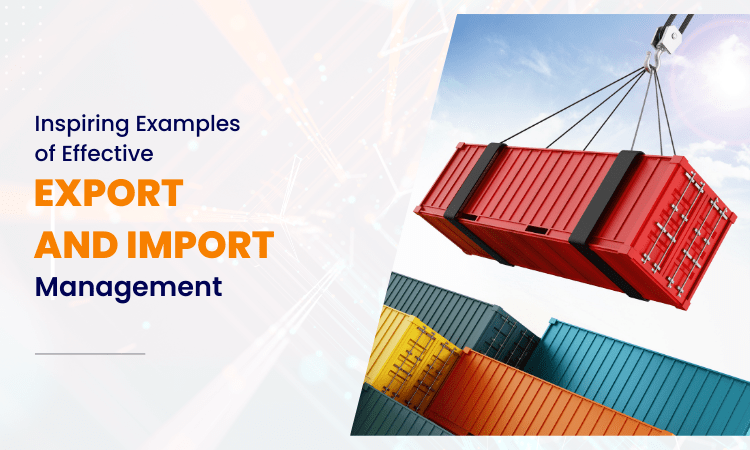
10. Success Stories: Inspiring Examples of Effective Export & Import Management:
The world of international trade is brimming with inspiring stories of businesses that have thrived through effective export and import management. Here are a few examples to spark your motivation:
Patagonia’s Sustainable Sourcing:
Renowned outdoor apparel brand Patagonia prioritizes ethical and sustainable practices throughout its supply chain. They leverage strong partnerships with international suppliers who share their commitment to environmental responsibility, ensuring responsible sourcing and minimizing their environmental footprint.
Tesla’s Global Expansion:
Tesla’s remarkable global expansion exemplifies strategic export management. By establishing efficient logistics partnerships and tailoring their marketing strategies to specific regions, they have successfully navigated cultural nuances and established a strong presence in international markets.
Chocolates of the World’s Diverse Portfolio:
This Belgian chocolate company leverages import management expertise to source high-quality cocoa beans from various origins. Their efficient logistics network and understanding of international regulations ensure timely delivery of these ingredients, allowing them to offer a diverse range of chocolates to customers worldwide.
Eko Atlantic’s Sustainable City Project:
This innovative project in Lagos, Nigeria, showcases the power of import and export management in large-scale endeavors. By effectively managing the import of construction materials and exporting finished products, the project is contributing to the development of a sustainable and thriving city.
These examples highlight the diverse ways businesses can leverage effective export and import management to achieve success in the global arena. Whether focusing on ethical sourcing, strategic market entry, or efficient logistics, these stories demonstrate the potential for businesses of all sizes to thrive in the interconnected world of international trade. They serve as an inspiration for businesses to embrace the challenges and opportunities that come with venturing into new markets, and to do so with a commitment to responsible and sustainable practices.
Conclusion:
Navigating the exciting world of export and import management may seem complex, but with the right knowledge, strategies, and partnerships, you can unlock the vast potential of global markets. Remember, success hinges on a combination of strategic planning, efficient execution, and continuous learning. Embrace the challenges, leverage the opportunities, and embark on your journey to success in the international arena.

